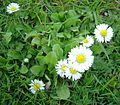Bellis perennis
This article needs additional citations for verification. (May 2008) |
| Bellis perennis | |
|---|---|

| |
| Scientific classification | |
| Kingdom: | |
| Class: | |
| Order: | |
| Family: | |
| Genus: | |
| Species: | B. perennis
|
| Binomial name | |
| Bellis perennis | |
Bellis perennis is a common European species of Daisy, often considered the archetypal species of that name. Many related plants also share the name "Daisy", so to distinguish this species from other daisies it is sometimes qualified as Common Daisy, Lawn Daisy or occasionally English daisy. It is native to western, central and northern Europe. The species is widely naturalized in North America, where it is considered an invasive weed.
It is a herbaceous plant with short creeping rhizomes and small rounded or spoon-shaped evergreen leaves 2–5 cm long, grows close to ground. The flowerheads are 2–3 cm in diameter, with white ray florets (often tipped red) and yellow disc florets; they are produced on leafless stems 2–10 cm (rarely 15 cm) tall. The lawn daisy is a dicot.
Etymology
It is thought that the name "daisy" is a corruption of "day's eye", because the whole head closes at night and opens in the morning. Chaucer called it "eye of the day".
Daisy is also a common girl's name and is a nickname for girls named Margaret, which originally comes from the Latin word for daisy.
Uses
It is not affected by mowing and is therefore often considered a weed on lawns, though many also value the appearance of the flowers. Several cultivars and hybrids have been selected with much larger flower heads up to 5–6 cm diameter and with light pink to purple-red ray florets.
Bellis perennis has astringent properties and has been used in folk medicine.[1]
Green leaves are edible, consume moderately.
It has traditionally been used for making daisy chains as a children's game.[2]
Gallery
-
Daisy flower extreme close-up
References
- ^ Howard, Michael. Traditional Folk Remedies (Century, 1987), p129
- ^ "Children's 'right to play'". BBC News. BBC. 2002-08-07. Retrieved 2008-11-02.
External links
- Bellis perennis (USDA plant profile)








